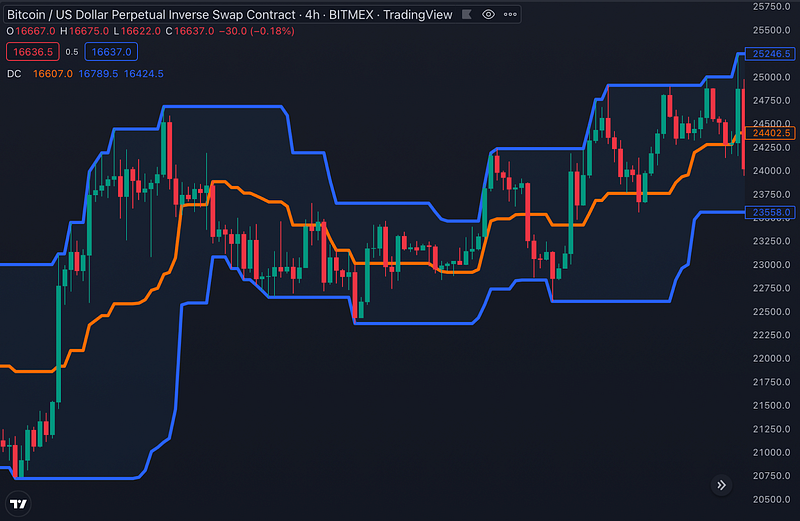Donchian Channels Indicator and Strategy
If you are a fan of technical analysis, then the Donchian Channels indicator is one that you should be familiar with.
The Donchian Channels indicator is a very simple but effective tool that can be used to identify potential breakout points in the market.
Donchian Channels indicator is created by taking the highest high and the lowest low over a specific period, typically 20 days. These channels can then be used to help identify potential trading opportunities.
In this blog post, we will explain what The Donchian Channels indicator is, how they are used, and what strategies can be employed when trading with them.
What is the Donchian Channels Indicator?
The Donchian Channels indicator is a technical analysis tool that is used to measure price volatility. The indicator is based on the concept of the upper and lower Bollinger Bands.
The Donchian channel is calculated by taking the highest high and lowest low of the past n periods, where n is typically 20.
The indicator can be used to identify trend reversals, and breakout opportunities, and to measure market momentum. The indicator can also be used as a trailing stop loss.
The Donchian Channels indicator is a versatile tool that can be used in several different ways. It is important to remember that the indicator is best used in conjunction with other technical indicators and analysis tools.
Donchian Channels indicator can be used on any time frame but is most commonly used on daily or weekly charts.

How to use the Donchian Channels indicator?
The Donchian Channels indicator is a technical indicator that can be used to identify breakout and trend-following opportunities.
The indicator is created by plotting an upper and lower band around a security’s price action, using the highest high and lowest low of the past X period. The default value for X is 20, but this can be modified to suit the trader’s timeframe and preferences.
When prices break out above or below the upper or lower Donchian Channel Bands, it can signal a potential change in trend.
If prices rally after breaking above the upper band, it could be an indication that prices are starting to trend higher. Similarly, if prices drop below the lower band, it could be indicative of a new downtrend.
To implement this strategy, traders would wait for prices to break out above or below the upper or lower bands and then enter a trade in the direction of the move.
Stop losses would be placed at the opposite band. For example, if prices break out above the upper band, traders would buy with a stop loss placed below the lower band.
This strategy seeks to take advantage of strong trends that can occur in markets from time to time.
Support and Resistance Levels for Donchian Channels
Donchian Channels indicator is a technical analysis tool that can be used to identify support and resistance levels for security. Support and resistance levels are important because they can help traders predict where a security’s price is likely to move in the future.
The upper line of the channel is created by taking the highest high of the past X time, while the lower line is created by taking the lowest low of the past X period of time.
These lines act as support and resistance levels for the security’s price. If the price bounces off of the upper line, it is said to be finding resistance at that level.
If the price falls to touch the lower line, it is said to be finding support at that level.
By identifying these support and resistance levels, traders can make predictions about where the security’s price is likely to move in the future.
They can also use these levels to place trades, either buying when the price touches support or selling when it hits resistance.
How to create a trading strategy with Donchian Channels
Donchian Channels indicator is a creative trading tool that can be used to develop effective trading strategies. Here’s how to create a trading strategy with Donchian Channels:
1. First, identify the market trend. The Donchian Channels indicator is most effective in trending markets.
2. Next, set up the Donchian Channel parameters. The default parameters are 20 periods for the upper and lower bands and the median line.
3. Then, wait for a breakout of the upper or lower band. A long position should be taken when the price breaks out above the upper band, and a short position should be taken when the price breaks out below the lower band.
4. Finally, set a stop-loss order at the opposite band. A long position should have a stop-loss order placed below the lower band, and a short position should have a stop-loss order placed above the upper band.
Donchian Channels at Traderlands Strategy Creator Tool
You can start creating a strategy by selecting “Donchian Channel Lower” and “Donchian Channel Upper” from the list. An example strategy is shown in the image below. You can use the Donchian Channels indicator to create a strategy after doing your own research.
Enter Algorithm Rules You Can Add To Strategy Creator

Exit Algorithm Rules You Can Add To Strategy Creator

WARNING: The entry and exit strategies in the images are prepared ONLY for educational purposes to explain how indicators work. It does not guarantee any profit.
When creating an algorithmic trading strategy, a rule set is usually created by using more than one indicator.
Other Indicators can be used with the Donchian Channels
Several other indicators can be used in conjunction with The Donchian Channels indicator to form a trading strategy.
These include the Bollinger Band, moving average convergence divergence (MACD), and Stochastic oscillator. Each of these indicators has its unique characteristics and can be used to identify different market conditions.
The Bollinger band is an indicator that is used to measure market volatility. It consists of two lines that are placed above and below the price action.
The top line is typically two standard deviations above the 20-period moving average, while the bottom line is two standard deviations below the 20-period moving average. This indicator can be used to identify overbought and oversold conditions in the market.
The MACD is an indicator that is used to measure momentum in the market. It consists of two lines, the MACD line, and the signal line. The MACD line is calculated by subtracting the 26-period exponential moving average from the 12-period exponential moving average.
The signal line is a 9-period exponential moving average of the MACD line. This indicator can be used to identify momentum shifts in the market.
The Stochastic oscillator is an indicator that is used to measure whether or not a market is overbought or oversold. It consists of two lines, %K and %D. %K is calculated by subtracting the 14-period low from the current close, divided by the 14-period.





